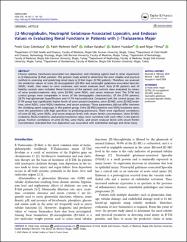beta 2-Microglobulin, Neutrophil Gelatinase-Associated Lipocalin, and Endocan Values in Evaluating Renal Functions in Patients with beta-Thalassemia Major
Özet
Chronic anemia, transfusion-associated iron deposition, and chelating agents lead to renal impairment in beta-thalassemia (beta-thal) patients. The present study aimed to determine the most reliable and practical method in assessing and predicting renal injury in beta-thal major (beta-TM) patients. Therefore, we assessed the predictive values of urine beta 2-microglobulin (beta 2-MG) and neutrophil gelatinase-associated lipocalin (NGAL) levels, their ratios to urine creatinine, and serum endocan level. Sixty beta-TM patients and 30 healthy controls were included. Renal functions of the patients and controls were evaluated by means of urine protein/creatinine ratio, urine beta 2-MG, urine NGAL, and serum endocan level. The beta-TM and control groups were comparable in terms of the demographic characteristics. Of the beta-TM patients, 26.7% had glomerular hyperfiltration and 41.7% had proteinuria. Compared with the control group, the beta-TM group had significantly higher levels of urine protein/creatinine, urine beta 2-MG, urine beta 2-MG/creatinine, urine NGAL, urine NGAL/creatinine, and serum endocan. These parameters did not differ between the chelating agent subgroups in the patient group. Urine beta 2-MG/creatinine and NGAL/creatinine ratios were the parameters with high specificity in predicting proteinuria. There were significant correlations of urine beta 2-MG, urine NGAL, and serum endocan levels with serum ferritin concentration. Urine beta 2-MG/creatinine, NGAL/creatinine, and protein/creatinine ratios were correlated with each other in the patient group. Positive correlations of urine beta 2-MG, urine NGAL, and serum endocan levels with serum ferritin concentration indicated that iron deposition was associated with endothelial damage and renal injury.


















